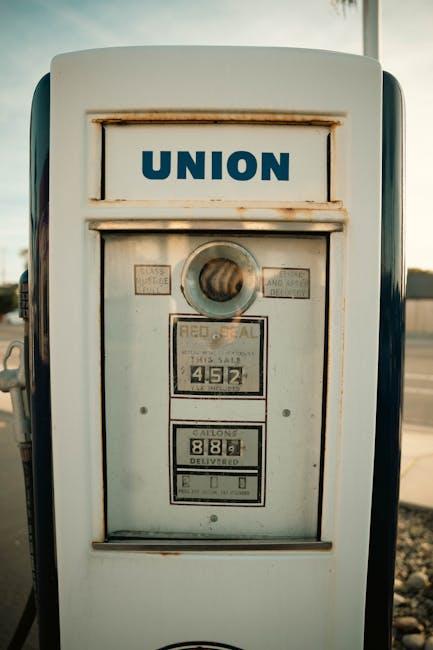Every drop of used motor oil tells a story—not just of miles traveled and engines maintained, but of responsibility towards our planet. While it may seem like just another byproduct of routine vehicle care, improper disposal of used motor oil can have serious environmental consequences. From contaminating soil and waterways to harming wildlife, the stakes are high. Knowing how to dispose of used motor oil safely and properly is a crucial part of conscientious vehicle ownership. In this article, we’ll guide you through simple, effective steps to ensure that your used motor oil doesn’t become a silent pollutant, but instead is handled in a way that protects both your engine and the environment.
Table of Contents
- Understanding the Environmental Impact of Used Motor Oil
- Safe Collection and Storage Practices for Used Oil
- Locating Authorized Recycling Centers Near You
- Step-by-Step Guide to Transporting Used Motor Oil Responsibly
- Exploring DIY Uses and Reuse Options for Used Motor Oil
- Common Mistakes to Avoid When Disposing of Used Motor Oil
- Q&A
- Key Takeaways

Understanding the Environmental Impact of Used Motor Oil
Used motor oil is more than just a waste product; it’s a potent environmental hazard if not managed properly. When improperly discarded—such as being poured down drains, onto soil, or into water bodies—it can contaminate groundwater, harm aquatic life, and disrupt ecosystems. A single gallon of used oil can pollute up to one million gallons of fresh water, emphasizing its toxic potential. The persistent nature of motor oil means it doesn’t easily break down, leading to long-term damage to flora, fauna, and even human health via contaminated water supplies.
Understanding the gravity of this issue can influence better disposal habits. Recycling and safe disposal are essential steps in mitigating the harmful effects. Many communities offer designated collection centers where used oil is either filtered and processed into new lubricants or responsibly incinerated. Below is a quick reference on the potential environmental impacts of mismanaged used motor oil and how responsible handling counters these risks:
| Environmental Risk | Effect | Proper Disposal Outcome |
|---|---|---|
| Soil Contamination | Reduces soil fertility | Prevents ecosystem damage |
| Water Pollution | Harms aquatic life | Protects wildlife habitats |
| Air Pollution | Releases toxins when burned improperly | Enables controlled recycling processes |
- Never pour used oil on the ground or into sewers.
- Use sealed containers to prevent leaks during transport.
- Locate certified disposal or recycling centers in your area.

Safe Collection and Storage Practices for Used Oil
Collecting used motor oil requires attention to detail and a commitment to safety to prevent spills and contamination. Always use a clean, leak-proof container with a tight-fitting lid, such as a plastic jug or metal can that previously held oil. It’s essential to label the container clearly as “Used Motor Oil” to avoid accidental mixing with other fluids that could complicate recycling. Make sure the container remains sealed during storage and transport, and avoid using containers that have held hazardous chemicals or food products.
Storing used oil properly also means keeping it in a cool, dry place, away from direct sunlight and extreme temperatures. This helps maintain the oil’s quality until it can be recycled. Consider the following practical guidelines for safe storage:
- Store containers off the ground on pallets or shelves to prevent rust and leaks.
- Avoid storing near ignition sources or in areas prone to flooding.
- Keep containers upright to minimize the chance of spills.
- Inspect containers regularly for signs of damage or leaks.
| Storage Tips | Benefit |
|---|---|
| Use proper container | Prevents leaks |
| Label clearly | Avoids contamination |
| Keep upright | Prevents spills |
| Store away from heat | Ensures safety |

Locating Authorized Recycling Centers Near You
Finding a place to safely dispose of your used motor oil is easier than you might think. Many communities partner with local automotive shops, service stations, and waste management facilities to collect used oil free of charge. Start by checking your city or county’s official website, where they often provide up-to-date lists of authorized drop-off locations. Additionally, national resources such as recycling directories or environmental protection agency sites can guide you to certified centers nearest to you.
When searching, consider the following tips to ensure proper disposal:
- Verify authorization: Confirm the center is licensed to handle used motor oil to prevent contamination and environmental hazards.
- Confirm operating hours: Some locations have specific hours or days for oil collection—plan ahead to avoid inconvenience.
- Prepare your oil: Store used motor oil in clean, leak-proof containers without mixing with other fluids, ensuring safe transport.
| Facility Type | Typical Location | Contact Info |
|---|---|---|
| Auto Repair Shops | Main Street or Industrial Areas | Phone or website listed locally |
| Recycling Centers | Municipal Waste Complexes | Check city government sites |
| Retail Auto Parts Stores | Shopping Complexes | In-store information desks |

Step-by-Step Guide to Transporting Used Motor Oil Responsibly
When it comes to moving used motor oil safely from your home to a recycling center, preparation is key. Start by storing the oil in a clean, leak-proof container with a secure lid—never use glass or containers that previously held food or beverages. Mark the container clearly with a label such as “Used Motor Oil” to avoid accidental misuse or spillage during transit. To protect your vehicle and the environment, place the container in a sturdy plastic bag or a secondary spill-proof vessel. Keep the oil upright and stable, ideally in a spot that won’t shift around during the drive.
- Use absorbent materials, like old towels or cardboard, to cushion the container.
- Avoid leaving the oil in direct sunlight or extreme temperatures.
- Transport in the trunk or flat cargo area rather than passenger seats.
- Carry enough containers if you have multiple oil changes to dispose of.
Before setting out, check the operational hours and requirements of your destination recycling center. Some facilities may limit drop-off times or require advance notice for larger volumes. To clarify proper disposal protocols, use the following quick reference table:
| Recycling Facility | Drop-off Time | Container Requirements |
|---|---|---|
| Local Automotive Shop | Mon-Fri, 9 AM – 6 PM | Sealed plastic container |
| City Waste Management | Sat, 8 AM – 12 PM | Original container or labeled bottle |
| Hazardous Waste Center | By appointment only | Commercial containers accepted |

Exploring DIY Uses and Reuse Options for Used Motor Oil
While disposing of used motor oil responsibly is crucial, exploring creative DIY uses can reduce waste and offer practical benefits. For instance, used motor oil can be repurposed for lubricating heavy machinery like farm equipment or chainsaws, where premium lubricants aren’t necessary. Some hobbyists use it for rust prevention on tools and metal parts, applying a thin layer to keep corrosion at bay. Additionally, mixed with certain additives, used motor oil can serve as fuel in specially designed heaters – although this requires careful handling and adherence to safety standards.
If you’re looking for safe ways to reuse this resource beyond recycling centers, here are some smart options to consider:
- Wood preservation: Used motor oil, carefully applied, can help protect outdoor wooden fences or posts from moisture damage, though it’s essential to prevent environmental runoff.
- Cold-weather protection: When mixed in small amounts with sand, it can create a gripping surface on icy driveways and walkways.
- Metalwork maintenance: Regularly applying used motor oil to garden tools helps extend their lifespan by reducing friction and rust.
| DIY Use | Benefit | Important Note |
|---|---|---|
| Tool Lubrication | Reduces rust and friction | Use a minimal amount, avoid excess drips |
| Wood Preservation | Enhances moisture resistance | Avoid use near water sources to prevent contamination |
| Fuel for Heaters | Alternative energy source | Only in approved devices, follow safety guidelines |

Common Mistakes to Avoid When Disposing of Used Motor Oil
One major pitfall is assuming that all disposal facilities accept used motor oil. Many people mistakenly pour oil down drains, on the ground, or into garbage bins, unaware of the environmental damage these actions cause. Improper disposal can contaminate soil and water, harming wildlife and even entering human water supplies. Always check with your local recycling centers or automotive shops to find proper collection points before you dispose of any oil.
Another frequent error is mixing used motor oil with other substances such as antifreeze, gasoline, or cleaning solvents. This mixing not only complicates recycling but can also be hazardous during transport and storage. To help you remember safer handling practices, here’s a quick reference table:
| Mistake | Why to Avoid | Better Practice |
|---|---|---|
| Pouring on ground or drains | Pollutes environment | Use designated drop-off points |
| Mixing with other fluids | Complicates recycling | Keep oil separate and sealed |
| Using non-sealed containers | Risk of spills and leaks | Store in clean, sealed containers |
Q&A
Q: Why is it important to properly dispose of used motor oil?
A: Used motor oil contains contaminants like heavy metals and toxins that can pollute soil and water if dumped improperly. Proper disposal helps protect the environment and public health by preventing these harmful substances from entering ecosystems.
Q: Can I just pour used motor oil down the drain or on the ground?
A: Absolutely not. Pouring motor oil down drains, onto streets, or into the ground causes serious environmental damage, contaminating water supplies and harming wildlife. It’s illegal in many places and can result in hefty fines.
Q: How should I store used motor oil before disposal?
A: Store your used motor oil in a clean, leak-proof container with a tight lid. Avoid mixing it with other fluids like antifreeze or gasoline, as this complicates recycling. Label the container to prevent accidental misuse.
Q: Where can I take used motor oil for disposal?
A: Many auto parts stores, service stations, recycling centers, and hazardous waste facilities accept used motor oil. Some communities organize special collection events or provide curbside pickup. Check local government websites for specific locations near you.
Q: What happens to used motor oil after I drop it off?
A: Used motor oil is typically recycled. It’s cleaned and re-refined into new lubricants, processed into fuel oils, or used as raw material for asphalt and other industrial products. Recycling saves energy and reduces the need for new oil extraction.
Q: Can used motor oil be reused at home?
A: While some motor oils can be reconditioned, it’s generally not safe or advisable to reuse your own used oil without proper refining equipment. It’s best to rely on professional recycling facilities to handle used oil efficiently.
Q: Does disposing of used motor oil require a fee?
A: Disposal policies vary by location. Many centers accept used oil free of charge as an environmental service, but some might charge a small fee. It’s wise to call ahead or check online to confirm.
Q: What about oil filters—how should I dispose of them?
A: Oil filters still contain residual oil and should be drained and placed in sealed bags or containers before disposal. Many recycling centers also accept oil filters because the metal can be recycled alongside the oil.
Q: How often should I dispose of used motor oil?
A: Dispose of used motor oil every time you change your vehicle’s oil—typically every 3,000 to 7,500 miles, depending on your car and the oil you use. Holding onto oil for too long increases the risk of spills and leaks at home.
Q: What is the biggest misconception about disposing of used motor oil?
A: A common myth is that a small amount of oil won’t harm the environment. In reality, just one gallon can contaminate a million gallons of water. Every drop counts, so proper disposal is essential to keeping our planet clean.
Key Takeaways
Disposing of used motor oil properly is a small act that carries a big impact. By taking a few mindful steps—whether locating a nearby recycling center, using designated collection sites, or following local guidelines—you help protect our waterways, soil, and communities from harmful contamination. Remember, the journey of your motor oil doesn’t end at the drain; it’s a cycle that, when managed well, supports a cleaner, healthier environment for all. So next time you change your oil, think beyond the garage—because responsible disposal is where good maintenance truly begins.

